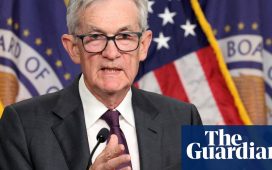Everyday issues such as trade are somewhat overshadowed this week by the events in Pennsylvania over the weekend. Oh, and also England losing the Euros football final to Spain. Not sure how long Sir Keir Starmer can hold on as prime minister unless he can deliver the basics. Today, I look at the US’s never-ending challenge in repairing the breaches in Fortress America, plus possible trouble ahead (when is there not?) at the World Trade Organization. Charted waters is on nickel prices. Question: how far does the US’s (or at least Biden’s) animus against China go? Far enough to tear up the United States-Mexico-Canada Agreement? Email me at alan.beattie@ft.com.
Get in touch. Email me at alan.beattie@ft.com
Keeping China out
“There is a crack in everything/That’s how Chinese imports get in” as the great bard Leonard Cohen didn’t quite sing. As the Biden administration’s time in office has proceeded, so its determination not to let its economy be infiltrated (and that often feels like the right word) by Chinese goods has had to adapt.
The latest, of course, is the drive to build a more or less standalone electric vehicle industry in North America, keeping out China through 100 per cent tariffs plus menacing noises about investigations into the national security challenges of EVs, aka “smartphones on wheels”.
There are a couple of problems with this. Canada and Mexico are deeply woven into US auto supply chains. Even former president Donald Trump didn’t make a determined effort to repatriate those parts of the industry to the US. His renegotiation of Nafta into the US-Mexico-Canada (USMCA) deal contented itself with tightening rules of origin (ROOs) and micromanaging labour standards, including hourly wage rates and union recognition in Mexico.
Being undercut by low labour (and environmental) standards is one thing, but Mexico acting as a backdoor for Chinese goods is somewhat more worrying. What some of us spotted more than two years ago is now pretty well established, that there aren’t two neat geopolitical blocs centred around China and the US, but a large mass of countries that pragmatically deal with both. Mexico is one such. Famously, the US restrictions on imports from China have merely led to a big increase in Chinese exports to Mexico.
The US is springing into action, to the extent that trade bureaucracies can spring, to block the holes that have emerged. It’s tightening up its rules on steel and aluminium (aluminum, whatever) through the supposedly national security-related Section 232 tariffs, including new duties to deter Mexico from exporting metal smelted in China (or indeed Russia, Belarus or Iran). As the redoubtable Mona Paulsen of the London School of Economics notes in this thread on the subject, it shows the problems the US has in struggling to manage its security concerns in isolation.
The bigger issue than steel and aluminium is obviously EVs, and here it gets even trickier. The US is looking to tighten the USMCA’s rules of origin to stop Mexico being used as an export platform for China-made EVs into the US market. But Chinese car companies including BYD, Chery and SAIC are setting up in Mexico itself. If their exports are made in Mexico by plants located there, ROOs don’t help, unless the companies in question are importing components from China.
If smartphones on wheels really are a security threat, the Biden administration — or possibly a future Trump administration, though he seems keen on having Chinese companies invest in the US itself — will have to come up with new tools to keep China out of the supply chain. The China hawks on Capitol Hill are all over this issue already.
The US’s fundamental problem is that it can’t as yet convince or coerce even close allies or trading partners to see China with the same alarm that it does. Nor does it have the market access to bribe them. The USMCA negotiation under Trump was a one-sided affair, getting concessions by using the leverage of threatening to take market access away. Machiavelli is often partially quoted as saying it’s better to be feared than loved. In fact he said the ideal was to be both, but there’s not a great deal of affection around for the US’s trade policy from either friends or enemies right now.
WTO snafu approaching: part 2
A straw in the wind of potential argy-bargy to come, the African Group of countries at the WTO have moved to reappoint director-general of the WTO, Ngozi Okonjo-Iweala, for another term in office. (Hat-tip to WTO guru Peter Ungphakorn for spotting this.) They’ve moved early: her current term doesn’t end until next year.
Why? Well, during the last appointment process, the Trump administration and particularly Robert Lighthizer, US trade representative, blocked her for months. (This was rather ironic in light of the hoo-ha over her having a US as well as a Nigerian passport, as uncovered by intrepid reporting at Bloomberg.) Apparently she was too World Bank-y and not trade-y enough, or something.
If Trump gets re-elected, Lighthizer or whoever becomes USTR might well also prevent her reappointment after they take office in January. If the WTO members start the process now, they could possibly just about get it done before then. It would, however, require some creative use of the rules and they’d have to get all WTO members to agree. This has all the makings of a politically contentious and protracted brawl, which I’m sure we can all agree is just what the WTO needs.
Charted waters
Nickel prices have crashed — another example (along with lithium) of a mineral used in the green transition where concern about China or other buyers cornering the world market turned out to be heavily overdone.

Trade links
Is a terrifying alliance between China and Russia threatening to pull other trading powers into its grip? Yes, if you want to freak out about the serial opportunist Narendra Modi going to Moscow and hugging President Vladimir Putin, but no, if you note that Russia’s much-vaunted use of the renminbi rather than the dollar is hitting a ceiling.
A spirited, pseudonymous blast in the Asia Times about how Chinese subsidies are helping the world.
Relatedly, the FT’s Martin Sandbu on how European governments need to up their game to encourage battery production.
A particularly good “Factful Friday”, one of the regular pieces from academic Richard Baldwin, this time on which was or is the most dominant in world trade: the UK in 1800, the US in 1948 or China now.
The FT’s Peter Foster in his State of Britain newsletter looks at the problems with the UK aligning its rules with the EU even under its relatively Brussels-orientated new government.
Trade Secrets is edited by Harvey Nriapia today









